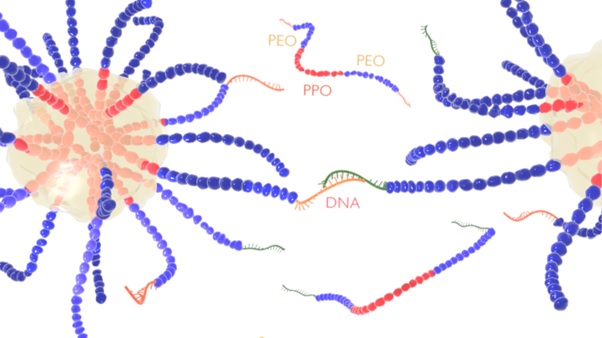Objective
Setting up a Soft Matter Group that allows us to design and create nanoporous materials with well-defined pore-size distributions to study flow of complex fluids and gases through them. We employ various video-microscopy and micro-rheology techniques combined with simulation studies to study primarily dense colloidal suspensions and polymer gels that serve as biomimetic model systems. Our findings will be used to develop upscaling models that relate nano to bulk behaviours.

Description
Understanding the flow of binary fluids through media with completely random pore-size distributions remains challenging, because it is both difficult to design such systems in the laboratory and often 3D porous systems are opaque. Examples of nano-porous media are for instance bioengineered membranes mimicking natural filtration systems to provide smart, implantable drug-delivery systems, bioartificial organs, and other medical devices, but they also constitute the cathode material in rechargeable lithium-ion batteries, membranes for desalination or even in the development of random lasers. The Eiser group focuses on 4 main topics:
- Building colloidal networks with well-defined pore-size distribution: Using our experience using short strands of DNA attached to colloids as highly selective, thermo-reversive glue to build transparent, model-porous networks embedded in a microfluidic channel and employing confocal microscopy to study binary flow through them as function of pore-size distribution, wettability, flow pressure and other properties.
- Sustainable stabilization of clay-rich ground: Clay suspensions/gels as nanoporous colloidal systems will be further developed to study transport through them when exposed to freeze-thaw cycles mimicking for instance thawing in permafrost. In particular, we will use the interactions and results from mechanical measurements (e.g. microrheology) relating to the nanoscale to develop up-scaling models to understand the large-scale behaviour of clay-rich soils.
- Sustainable nanocomposite-films and coatings: Transparent films made of natural clays and biopolymers have proven to have excellent mechanical and other physical properties. We will develop these systems into protective coatings, e.g. for solar cells, in particular studying the transport properties of gases through them, experimentally and developing a coarse-grained model for the nanocomposite.
- Highly selective bio-sensors: We use our DNA-functionalized colloidal systems to develop highly sensitive and selective diagnostic tools for easy pathogen-DNA detection.
Principal Investigator for Research Theme 4: Professor Erika Eiser
Partners:
Alex Hansen, Eirik Flekkøy, Signe Kjelstrup, Øivind Wilhelmsen, Sayed Ali Ghoreishian Amiri, Dag Breiby, Astrid de Wijn, Raffaela Cabriolu, Knut Måløy, Marcel Moura
Invited Talks:
- July 2022: Workshop on Non-Newtonian Flow in Porous Media, Fortaleza, Brazil. Title: ´Designer-Made, Colloidal Materials for the Study of Flow in Pores Media´.
- June 2022: A Random Walk In Soft Matter – Conference in Honor of Jacob Klein: Weizmann Institute of Science. Title: ´Optofluidic crystallization of colloids tethered at interfaces´.
- June 2022: From Water to Colloidal Water Conference in Honour of Francesco Sciortino, Rome, Italy. Title: ´Optofluidic crystallization of colloids tethered at interfaces´.
- Feb. 2022: Invited talk at the international Workshop on Advanced Materials in Ras al Khaimah, UAE (United Arab Emirates): 13th meeting in the IWAM series. Title: ´Optofluidic crystallization of colloids tethered at interfaces´.
Selected recent publications:
T. Erdem, M. Zupkauskas, T. O’Neill, A. Cassiagli, P. Xu, Y. Altintas, E. Mutlugun, E. Eiser ´Magnetically controlled anisotropic light emission of DNA-functionalized supraparticles´ MRS Bulletin Doi:10.1557/s43577-022-00352-z (2022)
A. Mukhopadhyay, I.D. Stoev, D.A. King, K.P. Sharma, E. Eiser ´Amyloid-Like Aggregation in Native Protein and its Suppression in the Bio-Conjugated Counterpart´ Frontiers in Physics 10, 924864; DOI: 10.3389/fphy.2022.924864 (2022)
T. Erdem, T. O’Neill, M. Zupkauskas, A. Caciagli, P. Xu, Y. Lan, P. Bösecke, E. Eiser ´Transparent Colloidal Crystals With Structural Colours´ Frontiers in Physics, Sec. Soft Matter Physics, 166; DOI: 10.3389/fphy.2022.847142 (2022)
I. D. Stoev, A. Caciagli, A. Mukhopadhyay, C. Ness, E. Eiser ´Bulk rheology of sticky DNA-functionalized emulsions´ Phys. Rev. E 104, 054602 (2021)
A. Caciagli, R. Singh, D. Joshi, R. Adhikari, E. Eiser ‘Crystallization of interfacially tethered colloids in an emergent optofluidic potential’, Phys. Rev. Lett. 125, 068001; DOI: 10.1103/physRevLett.125068001 (2020)
T. Curk, C. A. Brackley, J.D. Farrell, Z. Xing, D. Joshi, S. Direito, U. Bren, S. Angioletti-Uberti, J. Dobnikar, E. Eiser, D. Frenkel, R.J. Allen ‘Computational design of probes to detect bacterial genomes by multivalent binding.’ Prog. Nat. Am. Soc. 117, 8719; DOI: 10.1073/pnas.1918274117 (2020)
Z. Xing, C. Ness, D. Frenkel, E. Eiser ´Structural and Linear Elastic Properties of DNA Hydrogels by Coarse-Grained Simulation` Macromolecules 52, 504 (2019)
Z. Xing, A.Caciagli, T. Cao, I. Stoev, M. Zupkauskas, T. O’Neill, T. Wenzel, R. Lamboll, D. Liu, E. Eiser “Microrheology of DNA-Hydrogels” Proc. Nat. Am. Soc. 115, 8137 – 6pp; DOI: 10.1073/pnas.1722206115 (2018)
L. Di Michele, F. Varrato, J. Kotar, S.H. Nathan, G. Foffi, E. Eiser, ´Multistep kinetic self-assembly of DNA-coated colloids´, Nature Communications, 4:2007, DOI: 10.1038/ncomms3007 (2013)
News & Views on Research Articles
August 2020: Highlighted PRL paper on Optofluidics:
https://physics.aps.org/articles/v13/s102
https://aps.altmetric.com/details/87217309
April 2020: Sidney College news: https://www.sid.cam.ac.uk/life/news/1116/compute-detection-of-viruses-says-sidney-fellow-and-other-researchers.html
Aril 2020: Business Weekly:
https://www.businessweekly.co.uk/news/academia-research/compute-detection-viruses-say-researchers
March 2020: News item on the University of Cambridge website: https://www.cam.ac.uk/research/news/identification-of-viruses-and-bacteria-could-be-sped-up-through-computational-methods
April 2020: News Item on PNAS paper on detecting bacterial DNA: https://www.ch.cam.ac.uk/news/study-shines-light-new-virus-detection-approach
